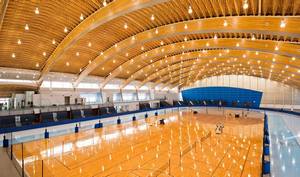|
Production of metal bearing structures: - delivery |
Production of LVL bearing structures: - delivery |
Fasteners for wooden structures are cheaper than for metal frame. Due to LVL light weight in comparison with metal, light cranes are used for installation, which also reduces total cost of mounted frame. Light weight of LVL and solid wood structures load foundations less and thus you can have additional savings on the scope of concrete for foundations and as a result on excavation works.

Reinforcement 6mm and main one 8 mm is used in armor-clad belt of LVL trusses.
Production time of LVL truss is 1 w/day.
Purchasing of fasteners (plates and bolts)
Coating (as an option). No additional treatment with protection means is needed.
Light-tonnage crane or winder
Salary for metalwork is several times higher than salary for work with LVL (wood).


Reinforcement 6mm and main one 12 mm is used in armor-clad belt of metal trusses, what entails an increase in purchase cost of reinforcement.
Production time of metal truss is 7 days.
Purchasing and consumption of a big number of electrodes.
Metal cleaning, welding joints cleaning - consumables + workers’ salary.
Structure priming and coating.
Large-tonnage crane.
Salary for metalwork is several times higher than salary for work with LVL (wood).
- Cost of material for one metal and LVL truss production is almost the same, but additional costs for metalwork are considerably higher than with LVL, namely:
- consumables
- protection means
- operation charges
- equipment rental cost
- workers’ salary
- production time
All the above is benefits indicator for LVL application in bearing structures production.
MATERIALS WE USE
Ultralam is modern composite structural material – an innovative product of deep wood processing.
BENEFITS:
Endurance
Very high strength
Bio and moisture resistance
Ecological safety
Optimal for “light structures”
Note: Calculation of material for trusses production is made on the basis of actually constructed house in Kharkov region in 2015.








